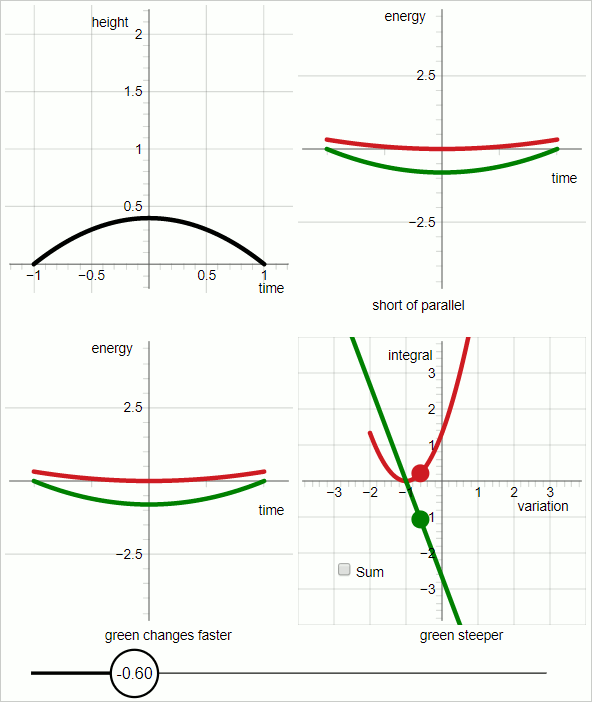The origin of the Lagrangian
Physics Asked by Hulkster on January 2, 2021
Is it possible to explain the form of Lagrangian $L=T-V$ in the following way?
The force that acts on a mass particle is due to the potential $V(x)$. This force drives the particle to minimize its potential energy. We also know that the attraction is a negative form of potential energy. On the other hand, the Law of inertia implies that the mass particle tends to hinder acceleration and thus minimize its kinetic energy. During a process of motion from the point $x_1$ to point $x_2$ between times $t_1$ and $t_2$, the mass particle tends at every moment to minimize the sum of its kinetic and attractive potential energy, i.e. the term $L=T-V$.
EDIT: We might also generalize the scenario of a falling mass particle, i.e. the decrease in potential energy equals the increase in kinetic energy, thus $T=V$. During the motion of short time intervals, it hold that $Tapprox V$. The total motion can be achieved by minimizing the action integral.
2 Answers
OP's heuristic explanation certainly contains the right physical ingredients of both dynamical and kinematic nature, although the important relative minus sign between $T$ and $V$ in the Lagrangian $L=T-V$ could preferably use some further elucidation. For a mathematical proof, see e.g. this related Phys.SE post.
Answered by Qmechanic on January 2, 2021
As you point out: surely the Lagrangian must be capitalizing on the fact that with all interconversion of kinetic energy and potential energy the decrease and increase must match each other.
We can restate that as follows:
During the entire time the rate of change of kinetic energy is equal to the minus rate of change of potential energy:
In mathematical notation:
$$ frac{d(E_k)}{dt} = frac{d(-E_p)}{dt} qquad (1) $$
Of course, in this equation the minus sign is there because the kinetic energy and potential energy change in opposite direction.
I will refer to this equation as the energy equation. To explain the form of the Lagrangian the energy equation is essential.
The animation below consists of 7 frames, each frame is displayed for 3 seconds.
In the upper-left sub-panel of the combined diagram the black line represents a trial trajectory. The animation sweeps through a range of trajectory variation.
In the upper right sub-panel:
Red graph: kinetic energy
Green graph: minus potential energy
The trial trajectory hits the true trajectory when the red graph and green graph are parellel to each other everywhere.
In order to compare the graph of the potential energy (green) has been flipped upside down, expressing the minus sign.
The diagram displays the following conditions:
Total duration: 2 seconds (from t=-1 to t=1)
Gravitational acceleration: 2 m/s
Mass of the object: 1 unit of mass.
With those conditions the true trajectory is given by the following function that gives the height 'h' as a function of time:
$$ h(t) = -t^2 + 1 $$
The variation has been implemented in the following way:
$$ h(t, p_v) = (1 + p_v)(-t^2 + 1) $$
That is, the trial trajectory is expressed as a function of two variables: time and the variational parameter p_v In the diagram the (current) value of the variational parameter is displayed in the "knob" of the slider.
In the lower-left sub-panel:
For values of the variational parameter up to zero the green graph changes faster, and for values of the variational parameter larger than zero the red graph changes faster. The point where the two change at the same rate is when the variational parameter is zero.
This difference in response to variation of the trajectory is visualized by taking the integral. As we know: integration has the following property: if you have a graph and the integral of that graph, then when the slope of the graph changes the value of the integral changes in proportion.
This explains why the Lagrangian ($T - V$) has that minus sign.
Lagrangian mechanics uses the energy equation (1) to find the trajectory with the property that the rate of change of kinetic energy matches the rate of change of potential energy.
This answer is a shortened version of an earlier, longer version (using the same 7-frame animation)
Answered by Cleonis on January 2, 2021
Add your own answers!
Ask a Question
Get help from others!
Recent Answers
- haakon.io on Why fry rice before boiling?
- Lex on Does Google Analytics track 404 page responses as valid page views?
- Peter Machado on Why fry rice before boiling?
- Joshua Engel on Why fry rice before boiling?
- Jon Church on Why fry rice before boiling?
Recent Questions
- How can I transform graph image into a tikzpicture LaTeX code?
- How Do I Get The Ifruit App Off Of Gta 5 / Grand Theft Auto 5
- Iv’e designed a space elevator using a series of lasers. do you know anybody i could submit the designs too that could manufacture the concept and put it to use
- Need help finding a book. Female OP protagonist, magic
- Why is the WWF pending games (“Your turn”) area replaced w/ a column of “Bonus & Reward”gift boxes?
